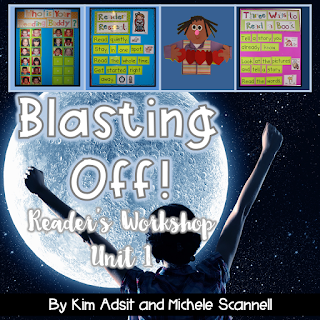When a baby picks up a book and babbles as he looks at the pictures, is that reading? When children tells a story as they turn the pages in the book because they have heard it many times, is that reading? How about when a children turns through a book and looks at the pictures and makes up a story, is that reading?
We explore this concept, "everyone is a reader", during a series of lessons for Reader's Workshop. We teach our children that there are three ways to read a book.
Day One might sound something like this:
Connect: "Remember yesterday when we..." (Remind the children whatever you taught them yesterday during reader's workshop.Teach: "This week we are going to learn that there are many ways to read a book. One way that you might read a book is to tell a story you already know. Let me show you what I mean." Here you would take a familiar book that you have read to your children several times. You will model how you can tell the story because you have read it so many times that it is in your heart. All through the lesson, share your thinking so that the children will hear how readers decide the story.
Active Engagement: "Now it is your turn." Now it is time for the children to practice what you just taught them. Provide the children with a collection of familiar books. The books can include ones that you have read aloud, ones that many children many know--such as Brown Bear, Brown Bear, song books like Five Little Ducks, or nursery rhymes such as Humpty Dumpty. Invite the children to select a book they know in their heart. The children will "read" the book as they turn the pages and tell the story. You will listen in as the children are working, making notes about what you see.
Link: "So remember boys and girls, today and everyday, good readers can read a book by telling a story they have read so many times, they know it in their heart." This is where you are reminding the children the point of the lesson.
Day Two might sound something like this:
Connect: "Remember yesterday when we said that one way you can read a book is to tell a story that you have read so many times that you know it in your heart?"Teach: "Today I am going to show you another way that you might read a book, you can look at the pictures and tell the story. Let me show you what I mean." Here you would take a book with great illustrations that tell the story. Think of your favorite authors/illustrators. You will model how you can tell the story just by looking at the pictures. All through the lesson, share your thinking so that the children will hear how readers decide the story.
Active Engagement: "Now it is your turn." Now it is time for the children to practice what you just taught them. Provide the children with a collection of quality books. The books can include any of your favorites. The children will "read" the book as they turn the pages, look at the pictures, and tell the story. You will listen in as the children are working, making notes about what you see.
Link: "So remember boys and girls, today and everyday, good readers can read a book by looking at the pictures and saying what is happening in the story." This is where you are reminding the children the point of the lesson.
Day Three might sound something like this:
Connect: "Remember yesterday when we said that one way you can read a book is to look at the pictures and think about what is happening so that you can tell the story?"Teach: "Today I am going to show you another way that you might read a book, you can read the words. Let me show you what I mean." This one is a little tricky because many of our youngest readers REALLY can't read the text. After many years, I finally figured out that it worked best for me if I used vocabulary books. Vocabulary books are the books that have one word and a picture of that word. I know they are aren't actually reading the word. But, by doing this, I can model pointing to the word and reading it. You can also use concept books such as, abc books, number books, shape books, etc. All through the lesson, share your thinking so that the children will hear how readers decide the story.
Active Engagement: "Now it is your turn." Now it is time for the children to practice what you just taught them. Provide the children with a collection of vocabulary and concept books. The children will "read" the book as they turn the pages, point to the word, and say the word out loud. You will listen in as the children are working, making notes about what you see.
Link: "So remember boys and girls, today and everyday, good readers can read a book by looking at the word and saying what the word says." This is where you are reminding the children the point of the lesson.
Each day as I teach the lesson I am building this anchor chart. The anchor chart follows these guidelines:
- It is used as a reference tool.
- It bullets your lessons.
- It is made with the children.
Are you buying it? Are you ready to say all kids can read? I have one more trick that MIGHT just convince you! Watch this video of one of our newest readers! We couldn't be prouder! Do you know this reader?































No comments:
Post a Comment